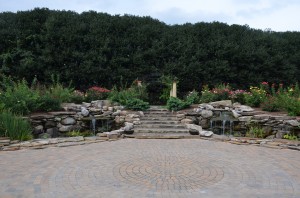Hollies and the winter season work well together. Female hollies with bright red fruits (yellow-fruited forms also) contrast with their glossy evergreen foliage. ‘Nellie R. Stevens’ holly (NRS), a female form, is a cross between English (Ilex aquifolium) and Chinese (I. cornuta) hollies. NRS is the popular holly choice in Southern landscapes (USDA hardiness zones 6 to 9).
Hollies are dioecious, requiring both a male and female parent for fruit formation. NRS holly exhibits the trait of bearing small numbers of seedless parthenocarpic fruit, without a male pollinator being present. More fruits are produced when NRS is properly mated with male holly cultivar ‘Edward J. Stevens.’ One male holly adequately pollinates 8-10 female plants located within 200-300 feet.
Hollies should be spaced apart according to their mature size and purpose in a planting. A single NRS makes an outstanding stand alone specimen shrub or tree; or mass several together to form a tall privacy screen. Plant them on 12 foot centers (between plants). NRS is a strong grower at 20-30 feet height and 15-18 feet width over 30 years. NRS is long-lived and asks for very little maintenance.
Hollies prefer a mostly sunny location and moderately acidic, well-drained soil. Established hollies are good foragers for nutrients, and do benefit from regular feedings with acidic-based fertilizers such as Hollytone®, Miracid®, or Miracle Gro® according to package directions.
Dr. Ed Gilman, at the University of Florida in Gainesville, writes that NRS has been successfully planted in urban areas on soils that are droughty and poorly drained, and on sites with poor air quality.


 Posted in
Posted in 
